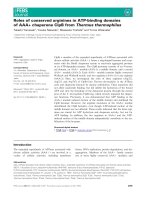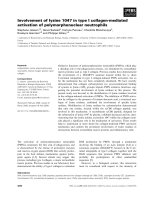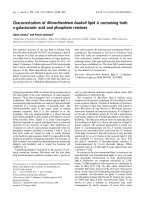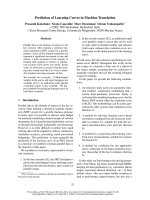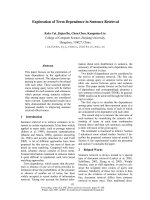báo cáo khoa học: "Estimation of realized heritability in a selected population using mixed model methods" ppsx
Bạn đang xem bản rút gọn của tài liệu. Xem và tải ngay bản đầy đủ của tài liệu tại đây (390.93 KB, 9 trang )
Estimation
of
realized
heritability
in
a
selected
population
using
mixed
model
methods
R.
THOMPSON
Animal
Breeding
Research
Organisation,
Edinburgh,
Scotland
Summary
The
use
of
mixed
model
methodology
to
estimate
selection
response
and
realized
heritability
from
selection
experiments
with
no
controls
is
investigated.
It
has
been
suggested
that
the
:egression
of
predicted
genetic
worth
on
cumulative
selection
differential
gives
an
estimate
of
heritability
in
a
selected
population.
An
assumed
value
of
heritability
is
used
to
predict
the
genetic
worth.
It
is
shown
for
2
simple
designs,
using
pedigree
information
on
one
sex
with
both
discrete
and
overlapping
generations,
that
the
predicted
values
depend
crucially
on
the
assumed
value
of
heritability
and
not
on
the
heritability
in
the
population.
Hence
the
regression
estimator
does
not
give
an
estimate
of
heritability
in
the
selected
population.
Key
words :
Realized
heritability,
mixed
models.
Résumé
Application
des
méthodes
du
modèle
mixte
à
l’estimation
de
l’héritabilité
réalisée
dans
une
population
soumise
à
sélection
Cette
étude
concerne
l’application
de
la
méthodologie
du modèle
mixte
à
l’estimation
de
la
réponse
à
la
sélection
et
de
l’héritabilité
réalisée
dans
des
expériences
de
sélection
sans
témoin.
Il
a
été
suggéré
que
la
régression
de
la
valeur
génétique
prédite
sur
la
différentielle
cumulée
de
sélection
fournit
une
estimation
de
l’héritabilité
dans
une
population
soumise
à
sélection.
Une
valeur
supposée
de
l’héritabilité
est
utilisée
pour
prédire
la
valeur
génétique.
On
montre,
dans
2
dispositifs
simples
utilisant
l’information
sur
les
apparentés
dans
un
seul
sexe,
avec
générations
séparées
ou
chevauchantes,
que
les
valeurs
prédites
dépendent
de
façon
critique
de
la
valeur
supposée
de
l’héritabilité
et
non
de
l’héritabilité
dans
la
population.
Par
suite,
l’estimateur
de
la
régression
ne
fournit
pas
une
estimation
de
l’héritabilité
dans
la
population
soumise
à
sélection.
Mou
clés :
Héritahilité
réalisée,
modèle
mixte.
I.
Introduction
In
experiments
to
evaluate
the
response
to
selection
there
is
often
a
need
to
disentangle
genetic
trend
from
environmental
effects.
Two
possibilities
are
to
use
divergent
selection
schemes
(HILL,
1972a)
or
to
use a
control
group
(HILL,
1972b).
These
designs
allow
regression
of
response
on
selection
differential
to
give
estimates
of
realised
heritability
(FALCONER,
1981).
B
LAIR
and
P
OLLAK
(1984)
investigated
a
third
possibility
of
using
mixed
model
methodology
on
a
selected
population
to
estimate
genetic
response.
Mixed
model
methodology
was
first
suggested
as
a
means
of
separa-
ting
genetic
from
environmental
trends
in
dairy
cattle
records
subject
to
culling
(H
ENDERSON
et
C
II. ,
1959).
It
was
later
discovered
that
this
technique
was
a
more
powerful
concept
useful
in
problems
of
prediction
of
breeding
values
corrected
for
fixed
effects
(H
ENDERSON
,
1973)
and
estimation
of
variance
components
by
maximum
likelihood
(H
ARVILLE
,
1977).
B
LAIR
&
P
OLLAK
(1984),
by
analogy
with
selection
experiments,
suggested
using
the
regression
of
predicted
yearly
genetic
means
on
the
cumulative
selection
differential,
b
BP
,
as
an
estimate
of
realised
heritability.
For
one
particular
sheep
selection
experi-
ment
they
state
the
standard
error
of
b
BP
is
about
the
same
as
that
for
an
estimate
based
on
using
both
selected
and
control
flock
data.
If true,
this
would
be
a
remarkable
result
showing
that
selection
experiments
could
be
more
efficient
without
control
lines
than
with control
lines.
B
LAIR
&
P
OLLA
K
(1984)
noted
that
the
results
and
conclusions
may
be
influenced
by
the
heritability
value
used
in
the
prediction
process.
It
seemed
useful
to
quantify
the
extent
of
this
influence.
Partly
to
see
if
it
was
merely
a
numerical
artefact,
and
partly
because
in
one
simple
case,
briefly
discussed
by
T
HOMP
-
SON
,
1979,
b
BP
is
exactly
the
value
of
heritability
used
to
predict
the
breeding
values.
By
algebraically
considering
2
simple
designs
it
is
shown
that
the
regression
coefficient
does
not
give
an
estimate
of
heritability
in
the
selected
population.
The
designs
considered
in
detail
are
partly
motivated
by
actual
selection
experiments
in
this
institute
(PURSER,
1980),
comments
by
B
LAIR
&
P
OLLAK
(1984)
and
last,
but
not
least,
algebraic
simplicity.
In
both
designs
a
pool
of
dams
of
constant
genetic
merit
is
assumed
and
pedigree
information
on
the
female
side
is
ignored
(a
common
occurence
in
dairy
sire
evaluation).
Design
I
is
a
design
where
in
each
of
T
years
sn
males
are
measured
and
after
the
first
year
n
sons
of
each
of
s
sires
are
measured.
In
order
to
reduce
genetic
drift,
suppose
there
is
within
family
selection
on
the
basis
of
the
measured
trait
so
that
only
one
son
of
!ach
sire
is
used
as a
sire.
This
design
has
no
overlap
between
generations.
_ j .
,j<
&dquo;
,
’
In
design
II
suppose
again
sn
males
are
measured
in
year
1.
Then
suppose
s
sires
are
selected
using
the
measured
trait
and
they
each
have
n
sons
in
year
2
and
in
year
3.
One
son
is
selected
from
each
of
the
s
sire
families
in
year
2
and
has
n
sons
in
year
3.
There
is
now
overlap
ip
year
3
with
offspring
from
sires
of
age
1
and
2.
II.
Analysis
’_
A.
Design
I
’
The
observation
and
predicted
additive
genetic
value
for
the
ith
animal
in
year
1
will
be
written
as
y;
and
si
(i
=
1,
,
sn)
and
let
i
=
1,
,
s
represent
sires
that
have
offspring,
also
y,ij
and
s,ij
represent
the
measurement
and
predicted
value
for
the
jth
descendant
of
sire
i
in
year
t,
and
let j
=
1
denote
the
individuals
that
have
offspring.
Then
suppose
It
is
assumed
that
there
are
fixed
effects,
m&dquo;
associated
with
measurements
on
the
t-th
year
and
a
residual
variance
Qe
associated
with
each
observation.
When
there
is
no
selection
the
genetic
covariances
between
sires
can
be
derived
from
the
coefficients
of
parentage
and
the
additive
genetic
variance,
0
-;&dquo;
(K
EMPTHORNE
,
1957)
and
this
variance
matrix
will
be
denoted
by
Aor’
A.
It
is
well
known
that
the
genetic
variances
change
with
selection,
but
if
a
2AS
is
thought
of
as
the
additive
genetic
variance
in
the
base
population
before
selection
and
selection
is
on
traits
included
in
the
model,
then
a
conditional
argument
can
be
used
to
show
that
operationally
one
can
use
A(J’2
AS
as
the
genetic
variance
matrix
when
estimating
fixed
effects
(H
ENDERSON
et
al. ,
1959)
and
when
estimating
u2As
(Cuxrrow,
1961 ;
T
HOMPSON
,
1979).
In
the
appendix,
mixed
model
equations
are
given
and
manipulated
to
show
that
estimators
of
genetic
merit
and
year
effects
for
this
model
are :
where
h2
is
a
prior
estimate
of
heritability
and
1>w
=
3h
2
/(4 -
h2)
is
a
within
half-sib ’
family
estimate
of
heritability.
B
LAIR
&
P
OLLAK
(1984)
suggest
regressing
9,
on
the
cumulative
selection
differen-
tial.
For
this
design
the
cumulative
selection
differential,
CSD&dquo;
at
the
end
of
year
t
satisfies
CSD, =
(1/2)
CSD,
-
+
(1/2)
(y
; -
yj)
with
CSD
o
=
0.
The
predicted
mean
genetic
merit
is
a
multiple
of
the
cumulative
selection
differen-
tial
plus
a
correction
term
for
the
difference
in
heritabilities
in
the
first
and
succeeding
years
that
halves
each
year.
The
regression
of
s!+,
on
CSD!
gives
a
regression
coefficient
lying
between
11
&dquo;,
and
h2
and
tending
to
hw
as
t
increases.
0
c
A
slight
extension
of
the
notation
is
needed
to
deal
with
this
design
because
sires
have
sons
in
2
years.
Let
Y13ii
be
measurements
in
year
3
on
sons
of
males
in
year
1,
with
a
similar
definition
of
sire
effects.
r
-
/.&dquo;&dquo;/. ’ &dquo;’
Also
let
It
can
be
shown
from
the
results
in
the
appendix,
that
estimates
of
genetic
merit
using
an
assumed
value
of
heritability,
h2,
are
The
terms,
q&dquo;
q2,
q,
#A
can
be
found
from
functions
of
n and
h2.
In
table
1
are
given
values
of
q&dquo;
q,
and
q,
for
various
values
of
n and
h’
showing
that
q&dquo;
q2,
q3
increase
as
h’
increases
and
that
q,
and
q3
decrease
and
q2
increases
as
n
increases.
The
cumulative
selection
differentials
in
this
case
are
CSD, =
(1/2)
(y; -
y,)
and
CSD
2
=
(3/8)
(y
;
-
yj
+
(1/4)
(yi -
yz)
so
that
s.!,
=
11; CSD
t
+
(1/2’ ’)
(h
Z
- 1
1
;)
CSD,
+
q,
+,
z
z (h 2),
the
same
form
as
for
design
I
with
the
addition
of
an
extra
term
q,
+
,
z
(h
Z
).
In
order
to
interpret
the
z
(h
z)
term,
it
is
seen,
by
considering
the
year
effects
estimators
from
design
I,
that
there
are
in
design
II
two
estimates
of
m3
readily
available
i.e.
m3
=
y3
-
(1/2)
k
(y% -
y2
) -
(1/4)
hz
(y; -
y,)
and
m3
=
y,
3
-
(1/
2)
hz
(y; -
y,).
The
discrepancy
between
these
2
values
is
z
(h
2
).
This
is
used
in
the
mixed
model
approach
to
provide
information
on
m,
and
mz,
and
q,
and
q2
can
be
interpreted
as
measures
of
the
information
that
z
(h
l)
provides
on
m,
and
m,.
Alternati-
vely
consideration
of
repeat-mating
designs
(for
example,
G
IESBRECHT
&
K
EMPTHORNE
,
1965)
suggest
estimating
hs
=
u§J(u/
+
cT;
,s)
the
heritability
in
the
population
by
choosing
hs
so
that
z
(hs)
=
0.
As
the
expected
value
of
y! -
y&dquo; is
1/2
h _
2
(yz -
yz
) -
(1/4)
h;
(y
;
-
y,)
the
expected
value
of
b
BI
,
E
(b,,),is
a
function
of
h’,
n,
h,
and
the
selection
differentials.
When
(y
*
, —
y,) _
(yz -
y,)
then
n and
h.
have
little
effect
on
E
(b
o
p).
For
instance
for
n
=
30
and
h,
=
0,1
then
E
(b
o
p)
=
0.094,
0.291
and
0.493
when
hz
=
0.1,
0.3
and
0.5
and
when
n
=
30
and
h,
=
0.5
then
E
(b
o
p)
=
0.088,
0.280
and
0.483.
Again
showing
the
crucial
dependence
of
bop
on
the
assumed
value
of
heritability
hZ
and
not
on
the
population
value
h;
:
III.
Discussion
In
2
simple
designs
it
has
been
shown
that
bgp
does
not
estimate
heritability
in
the
selected
population.
This should
not
be
surprising
in
design
I
because
of
the
confoun-
ding
between
years
and
generations.
It
is
worrying
in
design
II
when
a
natural
estimator
of
heritability
is
available.
Actual
selection
experiments,
including
the
one
considered
by
B
LAIR
&
P
OLLAK
(1984),
are
often
more
complicated
than
these
2
designs.
For
instance
(i)
mass
or
index
selection
could
be
carried
out,
(ii)
measurements
and
pedigrees
on
females
might
be
available,
(iii)
there
could
be
more
overlapping
of
generations,
(iv)
other
effects
such
as
$age
of
dam,
partially
confounded
with
generations
need
to
be
estimated,
(v)
it
is
rare
to
have
equal
family
sizes.
To
take
account
of
(i)
one
could
try
to
explain
s,
in
terms
of
selection
differentials
within
and
between
families.
But
if
the
phenotypic
selectional
differentials
were
used
one
would
expect
b,,
to
be
larger
than
1>w&dquo;
but
not
as
large
as
h2.
The
actual
magnitude
depends
on
h,
and
the
actual
selection
scheme.
The
major
consequence
of
(ii)
would
be
to
reduce
11
;
to
within
full-sib
heritability
hz
/(2 -
h2
).
With
(iii)
the
definition
of
the
cumulative
selection
differential
needs
more
care
and
there
is
the
need
to
take
account
of
the
cumulative
selection
differential
in
the
contemporaries
(PURSER,
1980 ;
JAMES,
1977).
Both
(iv)
and
(v)
add
some
complexity
to
the
analysis.
None
of
these
reasons
suggest
that
bop
will
ever
be
a
reasonable
estimator
of
heritability
from
selection
experiments
without
control.
As
the
estimated
means
s,
are
derived
from
selection
differentials
they
are
not
observed
responses.
Therefore
the
variances
of
!,
_are not_
expressible
in
terms
of
the
drift
variances-HILL
(1972a)
derives
for
observed
responses
as
B
LAIR
&
P
OLLAK
(1984)
assume.
Obviously
when
the
value
of
h2
used
in
predicting
s,
is
the
value
in
the
population
then
the
calculation
of
s,
and
b
BP
can
be
useful
as
a
monitoring
device
for
the
selection
scheme
and
can
be
thought
of
as
a
sophisticated
version
of
the
predicted
response
h!m
rather
than as
a
measured
iesponse
to
selection.
However
in
selection
experi-
ments
there
will
usually
be
the
need
-ta
-generate
internally
some
evidence
or
tests
for
the
value
of
parameters
in
the
model
including
heritability.
Just
because
some
predic-
tion
of
s,
is
available
from
selection
experiments
without
controls
using
mixed
model
methods
does
not
seem
to
me
sufficient
grounds
for
recommending
the
use
of
such
designs.
Of
course
there
are
other
methods
of
estimating
heritability
and
some
of
these
are
related
to
equating
sums
of
squares
of
predicted
values
to
their
expectation
(T
HOMPSON
,
1977 ;
S
ORENSEN
&
K
ENNEDY
,
1984).
However
just
because
estimates
are
available
does
not
imply
that
designs
without
controls
are
particularly
efficient.
As
a
simple
example
consider
2
designs
for
2
generations
with
N
males
measured
in
the
first
generation.
In
the
first
design
offspring
are
raised
from
the
best
2n
males
and
heritability
estimated
by
regression
of
offspring
on
parent.
In
the
second,
n
males
are
chosen
at
random
(a
control)
and
the
best
n
from
the
remaining
N:
In
this
design
2
natural
estimates
are
possible,
one
by
comparing
the
response
and
selection
differential
and
another
by
regression
of
offspring
on
parent.
The
variances
of
the
3
estimators
are
then
inversely
proportional
to
(I
-
i
(i
-
x)),
i’
2
/2
and
1 -
i’
(i’
-
x’)/2
+
i’
2
/2
(for
example
HILL
(1970))
where
x
and
z
are
the
truncation
point
and
ordinate
for
a
normal
distribution
with
a
proportion
p
=
2n/N
truncated
and
i
=
z/p
and
x’,
z’,
i’
are
the
corresponding
values
for
p’
=
n/(N -
n).
For
example
with
n
=
10
and
N
=
100
then
relative
to
the
variance
estimator
in
the
first
design,
the
two
estimators
in
the
second
design
variance
0.68/4.57
=
0.15
and
0.49/4.57
=
0.11
showing
that
the
design
with
a
control
provides
almost
10 times
as
much
information
on
heritability
as
the
design
without
a
control.
Received
January
2,
1986.
Accepted
May
6,
1986.
References
B
LAIR
H.T.,
P
OLLAK
E.J.,
1984.
Estimation
of
genetic
trend
in
a
selected
population
with
and
without
the
use
of
a
control
population.
J.
Anim.
Sci.,
58,
878-886.
C
URNOW
R.N.,
1961.
The
estimation
of
repeatability
and
heritability
from
records
subject
to
culling.
Biometrics,
17,
553-556.
FALCONER
D.S.,
1981.
Introduction
to
Genetics
Statistics
(2
d
ed.).
340
pp.,
Longman,
London.
GmS]BREcHT
F.,
K
EMPTHORNE
0.,
1965.
Estimation
of
a
repeat
mating
design
for
estimating
environmental
and
genetic
trends.
Biometrics,
21,
63-85.
H
ARVILLE
D.A.,
1977.
Maximum
likelihood
approaches
to
variance
component
estimation
and
to
related
problems.
J. Am.
Stat.
Assoc.,
72,
320-338.
H
ENDERSON
C.R.,
1973.
Sire
evaluation
and
genetic
trends.
In
Proceeding
of the
Animal
Breeding
and
Genetics
Symposium
in
Honor
of
Dr.
J.L.
Lush,
111,
10-41.
ASAS
and
ADSA,
-
Champaign.
H
ENDERSON
C.R.,
K
EMPTHORNE
O.,
S
EARLE
S.R.,
V
ON
K
ROSIGK
C.N.,
1959.
Estimation
of
environ-
mental
and
genetic
trends
from
records
subject
to
culling.
Biometrics,
13,
192-218.
HILL
W.G.,
1970.
Design
of
experiments
to
estimate
heritability
by
regression
of
offspring
on
selected
parents.
Biometrics,
26,
566-571.
HILL
W.G.,
1972a.
Estimation
of
realized
heritabilities
from
selectad
experiments.
I.
Divergent
selection.
Biometrics,
28,
747-765.
HILL
W.G.,
1972b.
Estimation
of
realized
heritabilities
from
selection
experiments.
II.
Selection
in
one
direction.
Biometrics,
28,
767-780.
JAMES
J.W.,
1977.
A
note
on
selection
differential
and
generation
length
when
generations
overlap.
Anim.
Prod.,
24,
109-112.
K
EMFTHORNE
0.,
1957.
An
introduction
to
genetic
statistics.
545
pp.,
Wiley,
New
York.
PURSER
A.E.,
1980.
Comparison
of
expected
and
realised
responses
in
three
sheep
selection
experiments.
In
R
OBERTSON
A.
(ed.),
« Selection
Experiments
in
Laboratory
and
Domestic
Animals
»,
21-30.
Commonwealth
Agricultural
Bureaux,
Edinburgh.
S
ORENSEN
D.A.,
K
ENNEDY
B.W.,
1984.
Estimation
of
response
to
selection
using
least
squares
and
mixed
model
methodology.
J.
Anim.
Sci.,
58,
1097-1106.
T
HOMPSON
R.,
1977.
The
estimation
of
heritability
with
unbalanced
data.
II.
Data
available
on
more
than
two
generations.
Biometrics,
33,
497-504.
T
HOMPSON
R.,
1979.
Sire
Evaluation.
Biometrics,
35,
339-353.
Appendix
In
this
appendix
estimators
of
year
effects
and
mean
genetic
merit
are
derived
for
the
two
designs.
Design
I
Mixed
model
equations
(H
ENDERSON
,
1973)
for
this
design
have
a
simple
form
because
of
the
pattern
in
A-’.
1.
Let
G
=
Qe/a2A
=
(1 -
hl
)/h
I,
H
=
G/3
and
F = 1 + 4 H = (4 -
h 2)/3h
=
1/k,
then
estimators
of
mi,
s,
i
and
S,ii
satisfy
;
These
equations
can
be
thought
of
as
Aeast
squares
equations
with
extra
coeffi-
cients,
(i)
for
males
with
no
sons
(G
or
F —
1
depending
on
whether
their
fathers
are
measured),
(ii)
for
males
with
sons
(G
+
nH
or
F
,,
+
nH
depending
on
whether
r,
fathers
are
measured),
(iii)
for
sires
and
sons
(-
2H).
,/
By
adding
together
equationi
and
dividing
by
sn
it
can
be
shown
that
.
,
By
adding
together
equations
for
animals
not
selected
it
can
be
shown
that
so
that
the
mean
merit
of
animals
in
year
t
is
half
the
mean
merit
of
their
fathers.
The
ny<riL-of_ selected sires
in
year
t is the mean
merit.in
year
t
ptus the selection
diff!Leniia! +!!p! !me!ye of heritability _ __
Design
11
Eliminating
effects
for
males
with
no
progeny
and
adding
within
generations
it
can
be
shown
that
Manipulating
these
equations
(Al-5)
it
can
be
shown
that
where
z
(h
l)
is
defined
in
equation
(1)
and
ql,
q2,
q3,
q4
and
qs
are
solutions
for
m&dquo;
M2
, m3,
s;
and
s2
in
equation
(Al) -
(A5)
with
y,
=
y;
=
y2
=
yz
=
0
and
y&dquo; =
y3
=
-
1/2.
Hence
the
q
values
are functions ofoh
2
and
lo
The
mean
genetic
values
can
be
derived
from
the
estimates
W
inl
l
mz
and
rE
]afid
are
given
in
equation
(2) -
(4).



